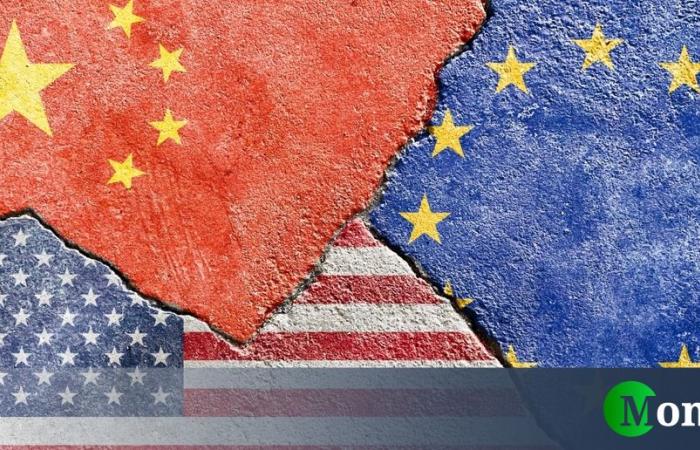The trade war Between Chinese, United States ed Europa with tariffs and retaliations – real or only threatened – is already redrawing routes, economic relations, balances between powers. But who would be the real winners (and the great ones losers) in this very conflictual dynamic?
Expert analyses abound on the topic, considering that the US elections of November could really sanction the escalation of the protectionism and rivalries between the world’s largest economies. If the United States promises a continuation of the tariff policy against China with both Biden and (above all) Trump, the dragon will not stand by and watch and has already accused the US of intolerable interference.
Moving in the same wake is theEuropa looking for reliable partners for raw materials and loyal competitors in key sectors such as electric cars. And it has not found this loyalty in Beijing, which on July 4 is ready to impose tariffs of up to 48% on electrified vehicles imported from China.
The economic scenario seems clear. Growing protectionism and the contraction of cross-border trade could slow down growth everywhere, but the United States, the world’s economic and currency superpower, have levels of protection that others do not. They are the real winners of the trade war? An analysis of who is the loser and who is the gainer in this heated rivalry.
US-China-Europe trade war: who are the winners?
The relatively closed nature of the economy, the global importance of U.S. stock and bond markets, and the weight of the dollar in international reserves make the winning USA leaving according to Jamie McGeever’s reflection on Reuters.
This does not mean that American power will not suffer: growth would slow down and inflation could rise. Higher inflation delays or perhaps eliminates the Fed’s interest rate cuts impacting the currency, while the growth in Europe and Asia would be more vulnerable.
In short, it is likely that the greenback acts as a lifeline to other currencies, none of which have the status of safe haven of the dollar. And in the world of exchange rates everything is relative.
Not only would the dollar be strengthened. The United States also appears to have the advantage growthgiven that a much less open economy compared to its European or Chinese counterparts means that trade disruption is expected to have relatively little impact.
According to the World Bank, the US exports of goods and services accounted for 11.8% of GDP in 2022, compared to 20.7% in China. Eurostat data show that last year, eurozone goods exports were worth 20% of GDP. The US trade deficit would also be reduced, as through l’onshoring, energy self-sufficiency it’s a push to relaunch production domestic manufacturing the US economy is restructuring.
“Further increases in trade policy uncertainty pose a significant downside risk to our global growth outlook in the second half of 2024 and into 2025… with larger effects in economies where exports account for a larger share of GDP”Goldman economists wrote Tuesday.
In an attempt to quantify the risks for growth in the United States and the Eurozone They analyzed the 2018-2019 trade war and employed three lenses: U.S. and European corporate commentary on trade uncertainty, stock returns on tariff announcements, and cross-country investment patterns.
The result was that an increase in trade policy uncertainty to 2018-2019 levels was likely would reduce GDP growth of three-tenths of a percentage point. The estimated blow to the growth of the euro area would be three times greater.
Who are the losers in a trade war?
China and Europe Are they the big losers in this trade battle?
The dragon has its weaknesses. China’s domestic economic problems and geopolitical position are enough to make foreigners wary of investing in the country. But it is no coincidence that foreign direct investment flows into China are plummeting at the fastest pace in 15 years, just as trade tensions they get worse.
The Chinese stocks are underperformingjust in positive territory for this year and after a terrible 2023. Beijing is struggling to support the yuan, which is at a seven-month low against the dollar.
European stocks and the euro they are not doing better and have not reacted favorably to the news on the duties that Brussels is imposing on some imports from China. Considering how much they are close trade ties between the euro zone and Chinathis should come as no surprise.
The Eurozone imports more goods from China than anywhere else in the world, and the yuan’s trade-weighted weight in the euro rivals that of the dollar. Trade tensions between China and Europe they will hit the euro hard.
And since the euro has a weighting of nearly 60% in the broader dollar index, there is naturally a strong inverse correlation between the fate of the euro and that of the dollar.
Deutsche Bank analysts expect the dollar to “remain stronger for longer” this year and next, although momentum could fade as the cycle lengthens.
A more belligerent stance on trade from whoever wins the White House in November, however, would represent a major positive development for the dollar and probably would push the euro back towards parity.




